We are reader-supported, earning a commission when you purchase through our links.
There’s no extra cost to you. Thanks for your support! Full disclosure here.
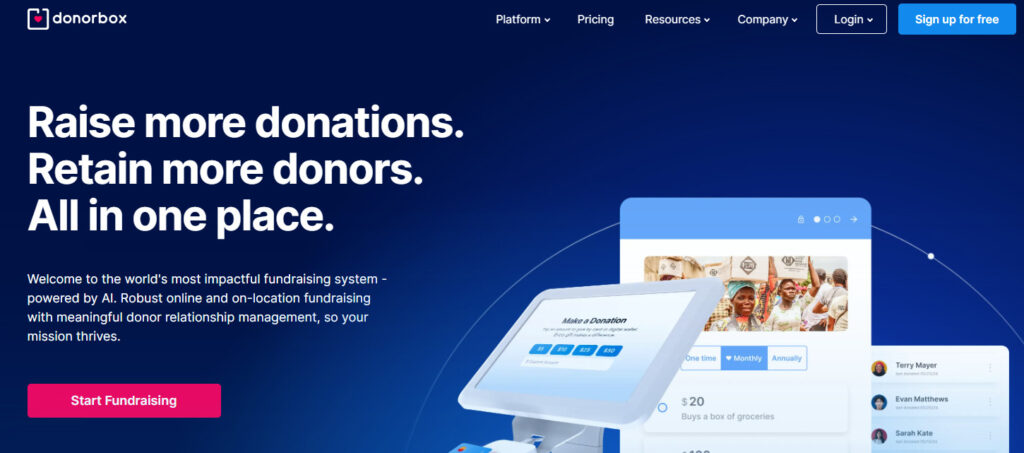
Donorbox is, in my honest opinion, the best donation app for Squarespace and Wix. Possibly WordPress, too. Their fee is likely the cheapest you’ll find, and the forms are beautiful. It lacks a fully-featured CRM for donor management, but that’s no fault of its own. Donorbox accomplishes exactly what you need it to–accept donations online, including recurring ones–and integrates well with other tools for everything else.
Read on for our full review, or sign up with Donorbox here.
Price
⭐⭐⭐⭐1/2
Cheapest we’ve seen for small nonprofits, even with add-ons.
Features
⭐⭐⭐⭐
For a donation plug-in, it nearly has it all.
Ease of Use
⭐⭐⭐⭐⭐
Drop-dead easy, but still pro-user friendly.
Support
⭐⭐⭐⭐
No phone support, but they seem to be responsive to email tickets.
Pros
✅ Best value out there
✅ Conversion-optimized donation forms
✅ Integrates with everything
Cons
⛔ No phone support
⛔ No branded dashboard for donors
Sign up With Donorbox
Just a flat 1.5%! Add-ons $8 – $50/mo.
Before starting The Digital Nonprofit blog, I used to consult with nonprofits on web design and marketing. If I was working with small-to-medium-sized organizations, chances were they used a website builder like Squarespace, Wix, or Weebly and wanted to migrate out.

Those platforms attract a lot of start-ups because they’re cheap, have no code, and make pretty decent websites. And I’m not out to trash them–this site uses Squarespace too! They’re especially a great fit when you just need a site and a place to collect donations.
That’s all well and good until the nonprofit grows and wants more advanced fundraising features like recurring donations. Squarespace donations only allow one-time gifts, Wix doesn’t have a donation app worth a damn, and Weebly’s donation process is really an eCommerce checkout.
So what can you do?
Feeling Trapped on Squarespace?
If you’re reading this article, chances are you turned to Google and typed in stuff like “recurring donation plugin” or “donation platform.” But usually, the results are useless support articles or sales pages for big donor management software.
Being in this spot is frustrating; you feel limited by your current setup, but your organization isn’t quite ready to migrate to WordPress or switch everything to Salesforce. It feels like a catch-22.
If you want to make some incremental upgrades to how you accept donations, avoid being wedded to any one platform or software, and have the ability to grow & change in the future, Donorbox is absolutely the tool for you.
What is Donorbox?
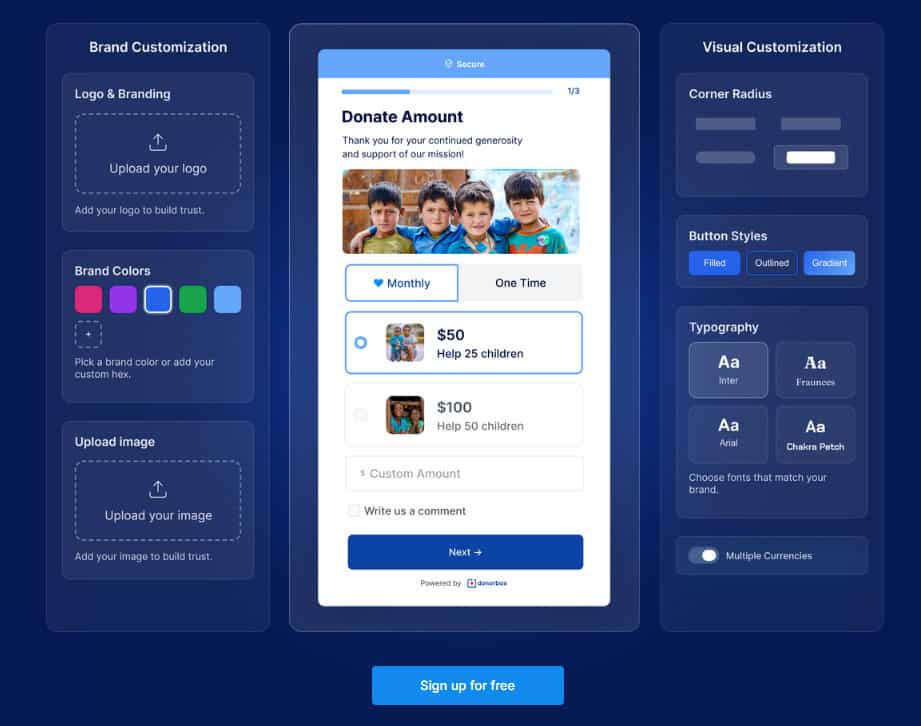
Donorbox is a platform-agnostic, embeddable donation app that is designed for simplicity. Just add the donation button, custom form, or page link to your website, and you can start accepting donations immediately. That includes advanced functionality like recurring donors, suggested amounts, and corporate matching.
By platform agnostic, I mean that Donorbox doesn’t care what tools you use or where your website is hosted. It can go anywhere you’re able to copy-paste HTML code or add a link. And it can integrate with any software that uses Zapier, so it’s easy to swap in and out as your needs change.
I should note that Donorbox is not really a donor management or CRM tool. While it does keep track of donor profiles and can even generate year-end reports, it’s not a competitor to Salesforce or Neon. Rather, it’s complimentary. Donorbox is fantastic at facilitating donations and online fundraising, but medium-to-large nonprofits probably want to layer it with another tool to keep track of their donor relationships.
The Donorbox Review
So what’s it like to use Donorbox? In this review, I’ll walk you through the software, highlight the major quirks and features, and show you how we used it to create a sample donation page.
- Donation Types and Form Fields
- Customization and Design
- Setting up Donorbox
- Integrations
- Accounting and Security
- Support
- Price
Donation Types and Form Fields
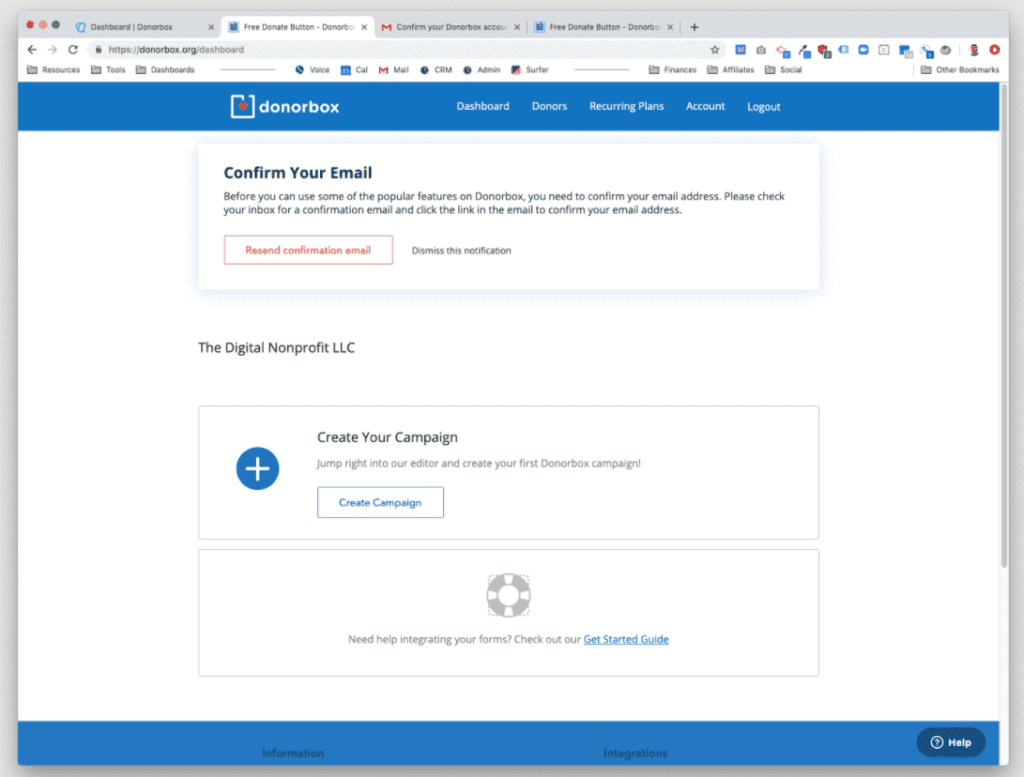
When you log into Donorbox for the first time, you’re greeted with a nearly empty screen that prompts you to “Create Your Campaign”.
Campaigns are customized donation pages and/or forms; you can and should create as many as possible. NextAfter found that campaign-specific donation pages increase donations by about 20%.
For our example, we’ll create a campaign called “Save the Trees”. After clicking to create a campaign, Donorbox gives us the ability to add details about our campaign, including images and video.
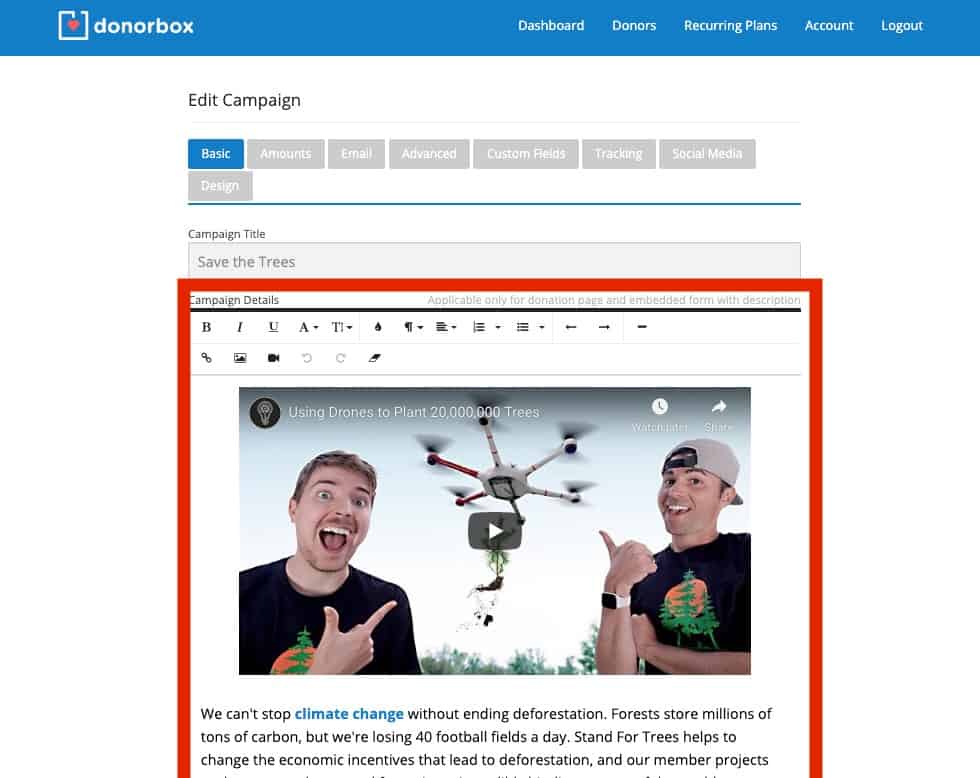
The next few screens present a litany of options to customize the types of donations you’d like to accept, and what fields should be in the form. Nearly every option conceivable is available to you.
For starters, you can add the basics like suggested donation amounts, a fundraising goal with a progress bar, and enable or disable recurring donations at set intervals.
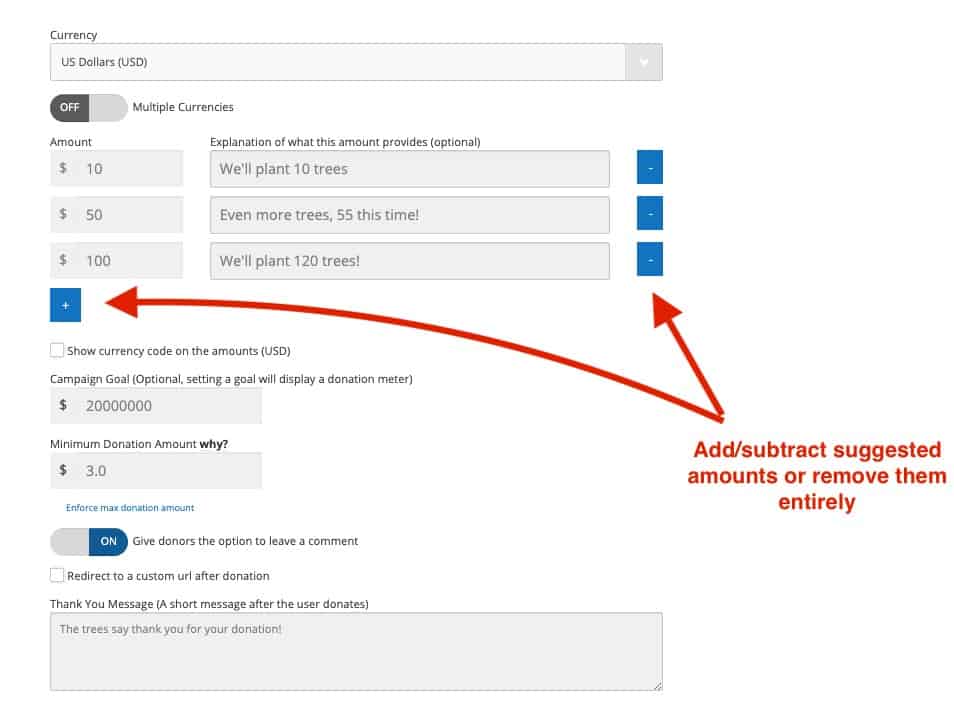
You can also allow less common, but equally important options like memorial gifts, anonymous donations, multiple currencies, and company matching.
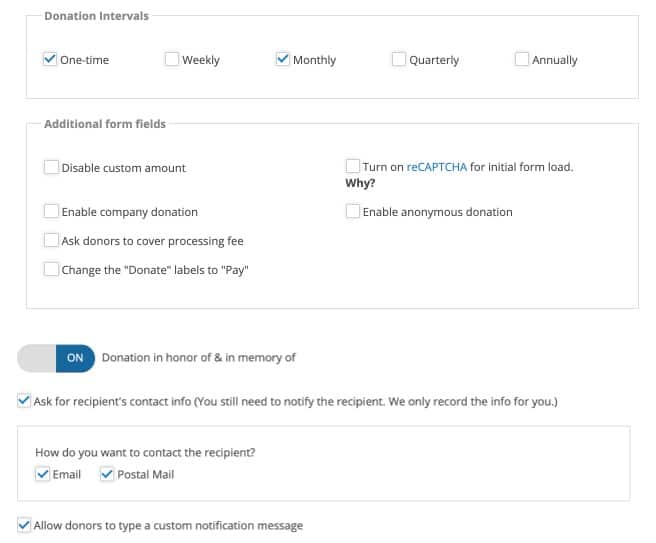
Donorbox partners with Double the Donation to create an amazing company match function I haven’t seen on other tools. The donor enters their company’s name, and the form instantly searches for a match; it’s absolutely seamless on the user’s end. As long as it generates $999/year or more for you, it’s well worth the add-on fee.
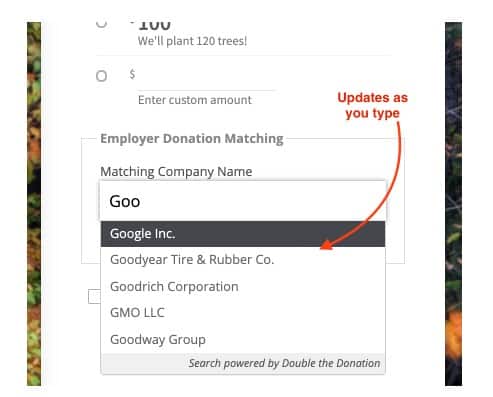
Another small, but great-to-have functionality is asking donors to cover the processing fee. Just check a box on the setup page, and it’s there! A very easy way to reduce overhead.
Suffice it to say that you’re able to add, remove, or modify just about every field—even ones I haven’t listed. If that’s not enough, you can create up to 10 of your own custom fields, make them optional or required, and select from input types like text, radio, checkbox, or dropdown.
Customization and Design
Customization seems to be one of Donorbox’s strong suits, and aesthetics are no exception. In the “Design” tab, you can change the form color and add a photo background and your nonprofit’s logo. One bummer is that outside of those 3 options, customizing the page design isn’t as easy as clicking buttons; you’ll need to dig into the CSS. Donorbox does allow you to target every aspect of the form with your custom CSS, but it’s a bit of a rude awakening after the super-easy setup beforehand.
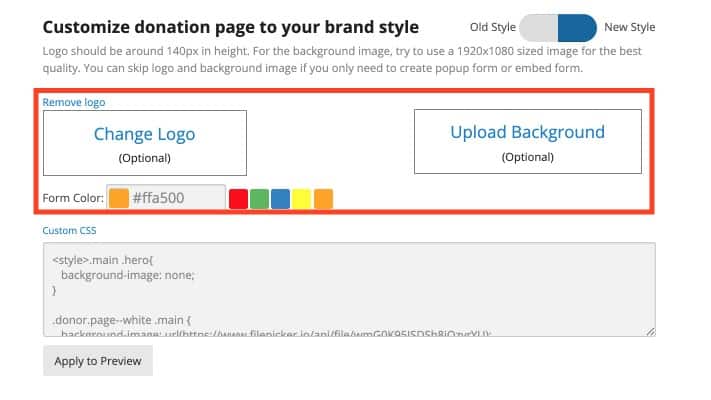
If you do have a super customized design in mind, I’d recommend building the page in Squarespace, WordPress, or whatever page designer you usually use, and then just embedding the Donorbox form. (We’ve embedded an example form below).
Luckily, the default form design is clean and neutral, so it shouldn’t need much tweaking, if at all. In fact, it seems like Donorbox put a lot of time and effort into making their form as close to perfect as possible. It follows best practices like pre-filling form fields, multi-step forms, and mobile-responsive design.
Setting up Donorbox
When it comes to integrating your campaign with your website, Donorbox is super easy to set up. All we need to do is copy and paste.
On the dashboard’s home screen, we can see the options for integrating the form with our website, and there are many: A simple link to the donation page, hosted by Donorbox, embedding the form on our site, a link/button that triggers a pop-up form, or a custom button that directs to the Donorbox-hosted page again.
Click one of those options, and you’re presented with even more ways to customize each instance of the donation form. For example, we could make a button that says “Donate $30,” and the pop-up form it triggers auto-suggests a $30 donation, like so:
^^Click it to see a real Donorbox form^^
And we can also make an embedded form for the same campaign and suggest a $60 donation, like this:
To reference NextAfter again, hyper-specific donation forms like these can make a 30% difference in the donation rate, so it’s absolutely fantastic that Donorbox includes functionality like this.
And again, this is all possible with a simple click & copy-paste.
To create a donation page on Squarespace, for example, we simply copy the embed code, create a new Squarespace page, add an “HTML Code” block, and paste. From creating my Donorbox account to finishing, I was able to create and embed my sample form in under 15 minutes, and theoretically start accepting donations immediately.
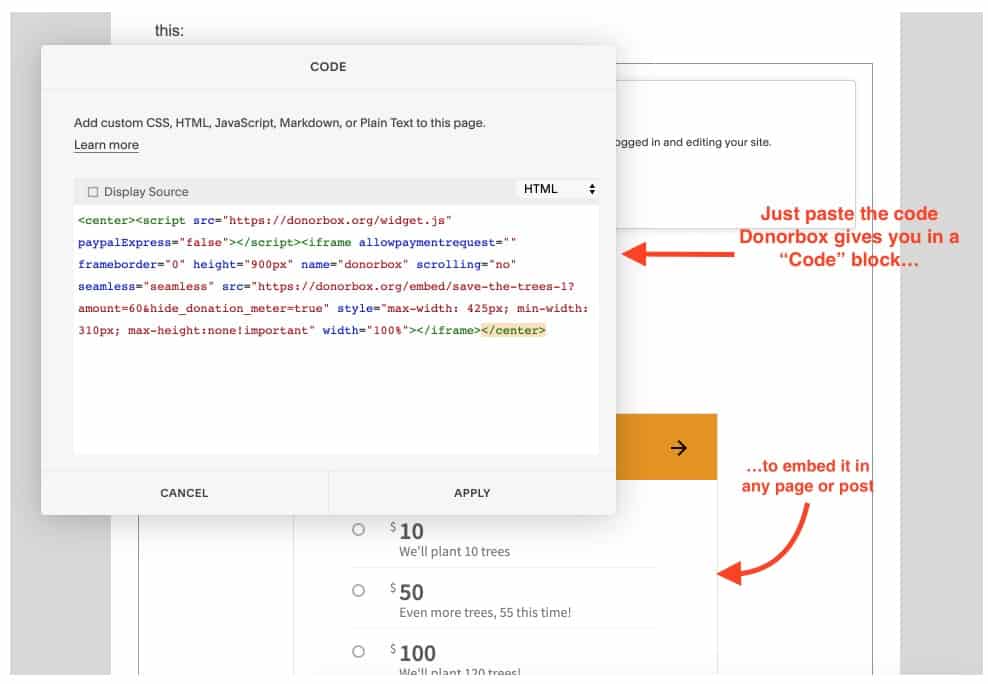
But before you take our Donorbox form live, you should make sure it integrates with your CRM and email marketing tools.
Donorbox Integrations
Salesforce and Mailchimp users will be pleased to know that there’s a native integration for those apps, though for a small monthly fee. If we wanted to email donors about future tree-related activities, we could have them added to the Mailchimp list of our choosing or synced with a Salesforce contact to make the connection near-seamless.

All other apps can be linked through Zapier, again for a small fee. Donorbox’s Zapier triggers are rather robust, so you should be able to simulate any kind of integration you need. I was able to quickly create a zap that checks my CRM for an existing contact record, and depending on whether one exists, updates it with new donation information or creates a new one entirely.
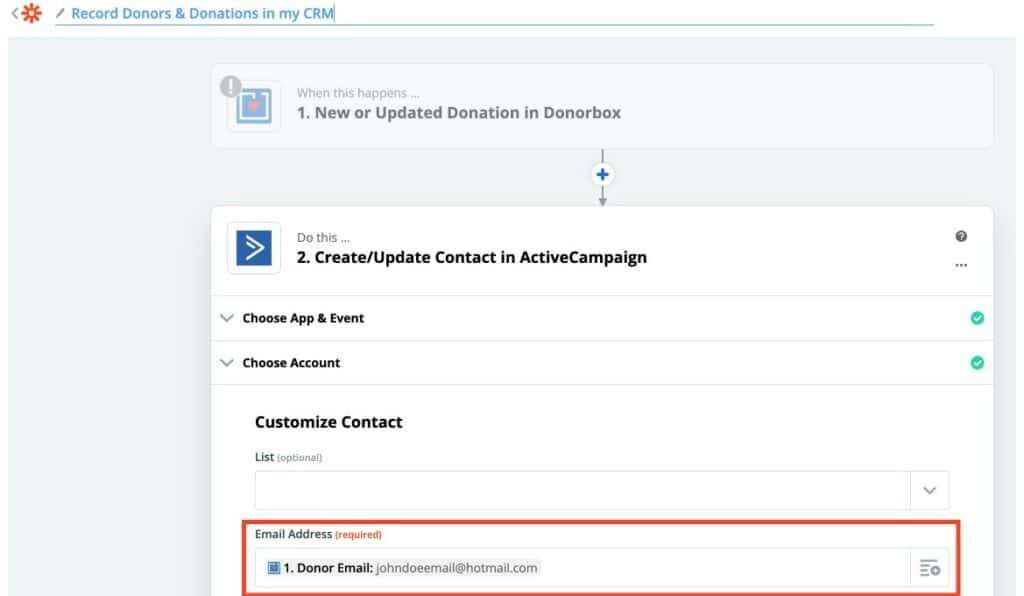
Accounting and Security
One area I always struggle with finding tools for The Digital Nonprofit is in this area, the boring but important stuff. There are so many tools out there that look spectacular and have amazing marketing, but they can’t export transactions or won’t let you edit the transaction receipts. You know, something dumb like that just forces you to throw the whole app out of the running.
In contrast, Donorbox excels at the boring but important stuff. The admin panel might not win any awards, but it’s super functional, and it has all the features you need to confidently accept donations.

For starters, Donorbox automatically sends donors email receipts, and you can customize them to your heart’s content. Tweak it so it suits your brand, or include important legal information—whatever you need.
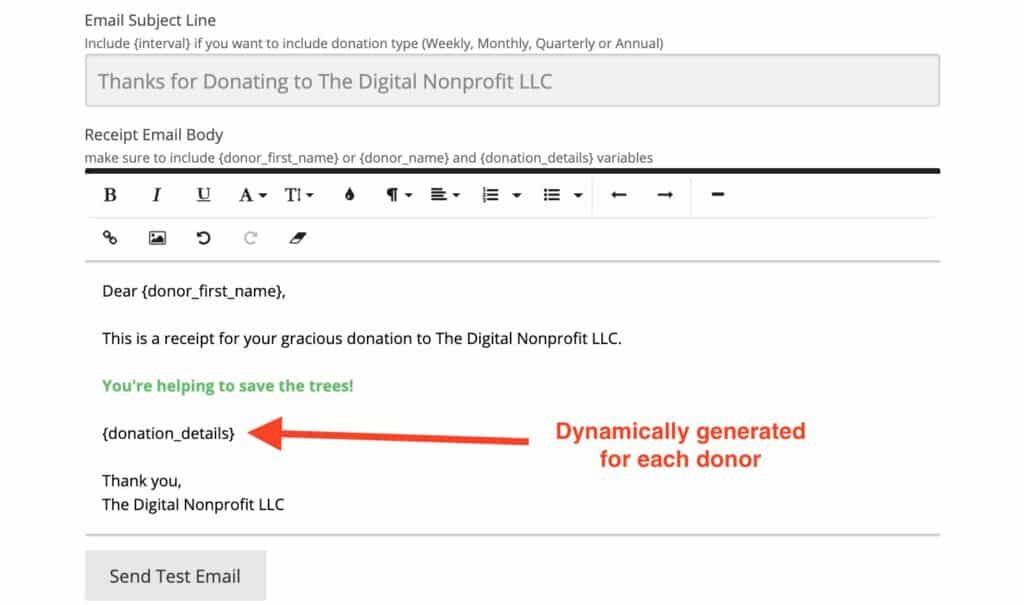
Similarly, you can send year-end reports to donors with a click of a button, and edit them as much as you want, too. A great idea would be to include a link to your nonprofit’s annual report and turn a boring annual tradition into an opportunity to build even more rapport with your supporters.
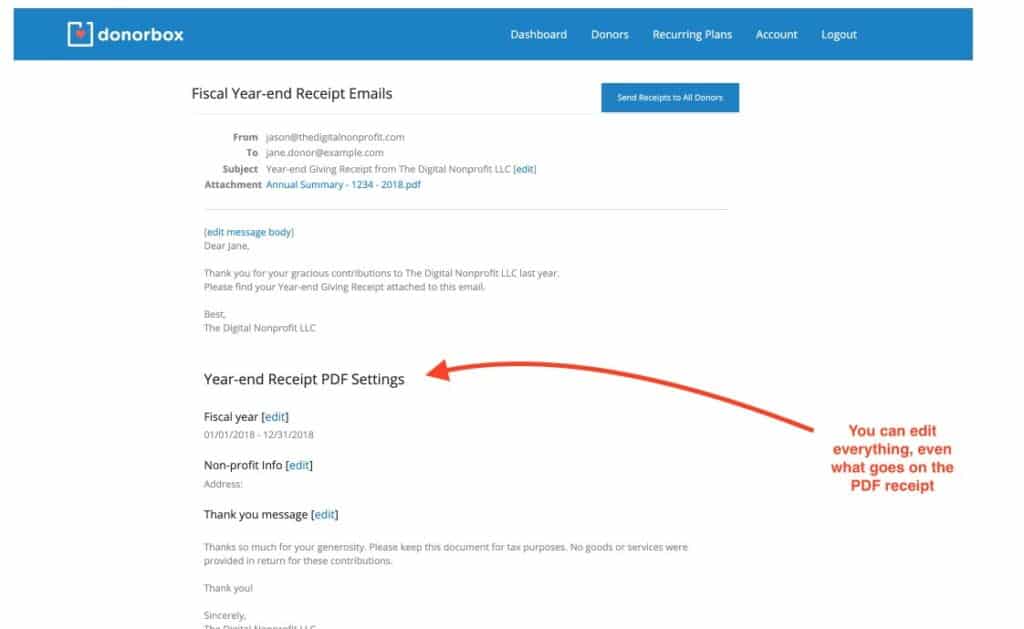
Donorbox has just released a new feature called Donorbox Events, which lets you create an event ticketing system in less than a minute! Not only is it fully customizable, but it can also generate tax-deductible tickets and manage registrations and ticket revenue in a breeze.
And while Donorbox isn’t ideal as a CRM, the database is certainly enough for accounting and auditing purposes. You can dig into any donor, all their donations, and every single minute detail about the transaction you could possibly need. The search, filter, and export features are top-notch, too, so keeping an account of finances should be no problem with Donorbox.
Is Donorbox Secure?
Short answer—yes. All Donorbox transactions are SSL/TLS encrypted, comply with SCA for Europeans, and don’t store financial information. Donorbox also has some of the strongest anti-fraud measures around.
In fact, if anything, you will probably be the weakest link. If you choose to embed a Donorbox form on your website, you’ll need to make sure your site is secured with HTTPS, too. (Squarespace, Wix, and Weebly sites are secured by default).
It may sound a bit scary, but all you really need to do is install an SSL Certificate on your site, and if your website has the little lock icon next to it when you look at your web browser address, you’re already good to go!

Let’s Encrypt is a free, easy way to do so, and Donorbox also offers its help in getting you set. It’s something your webmaster should be able to handle within a couple of hours. Outside of financial security, it’ll help your site’s SEO too.
Donorbox processes payments via Stripe, PayPal Express, Apple Pay & Google Pay, so you’re in good hands there, too. They are all industry-standard payment processors. You can also accept US Bank transfers.
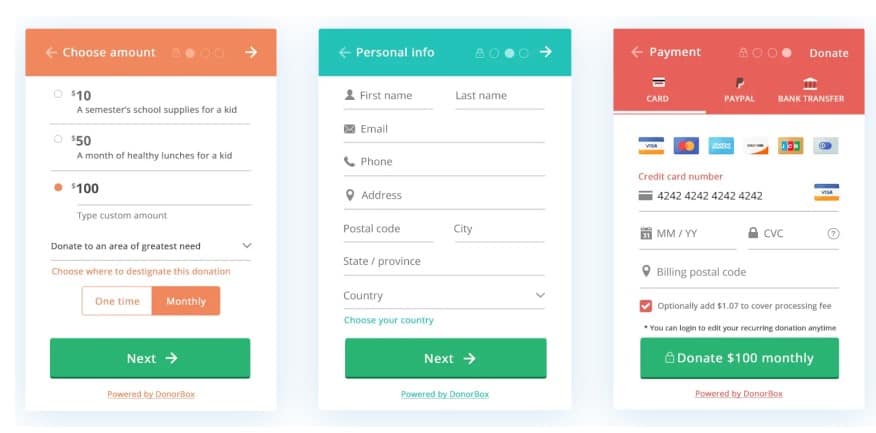
Support
No matter how tight the app is, there are always going to be hiccups and questions. We had one of our own when designing the example donation page: the background image only extended halfway down the page, and it left an awkward bar at the top where our logo was.
Once I gave up trying to solve it myself, I ventured over to the support tab and opened an email ticket. Donorbox doesn’t have phone support, but honestly, as long as the company responds quickly, I prefer to just leave an email and be on my way.
In this case, Donorbox did respond within the same day, and they were extraordinarily thorough.
Not only did the support staff have a solution, but they took the time to execute and test it. In their reply email, my support agent sent me the exact CSS code I needed to fix the issue. All I had to do was copy and paste.
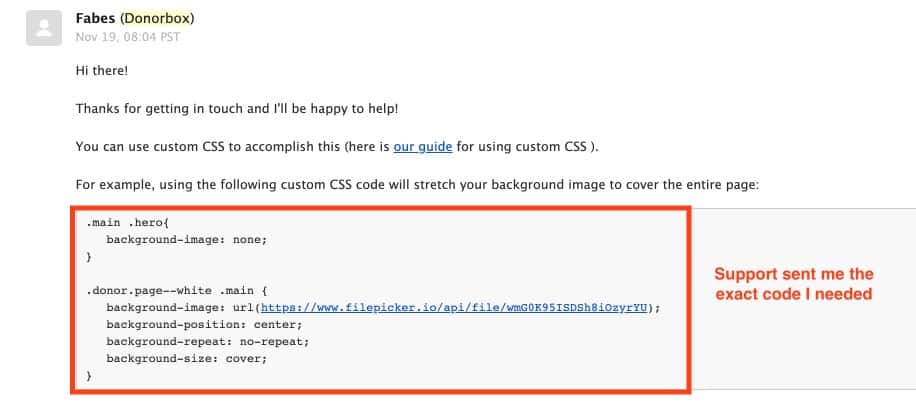
Pricing
Now, the keystone piece—what does it all cost?
You’ll be happy to know Donorbox forgoes the complicated pricing structure. They simply charge a flat 1.5% fee–the lowest % rate on the market.
Regular credit card processing fees do apply, but that’s not something Donorbox has control over. Their table here makes it all very clear.
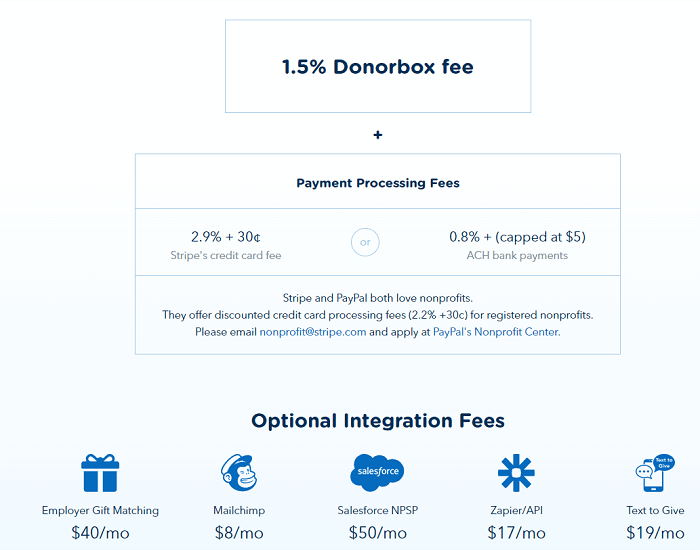
Employer gift matching and integrations are additional flat fees per month but are really marginal. As we mentioned before, if the employer gift matching gets you even $500/year in additional donations, you’ll have made a profit.
Overall, Donorbox fees are some of the lowest in the industry. Combined with the ability to ask donors to cover the fees, it really becomes appealing.
The best part is that there are no setup fees, so you can try out Donorbox without ever spending a penny.
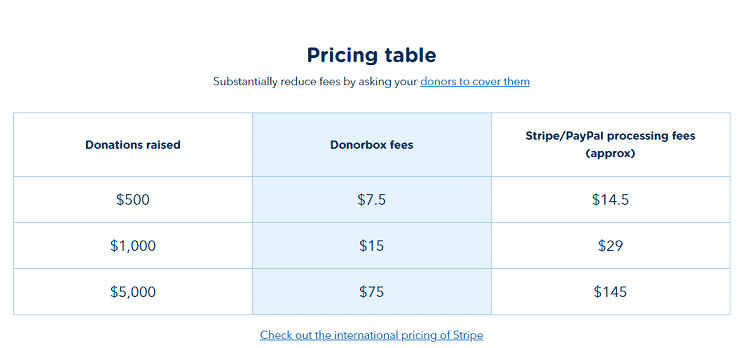
Conclusion – Is Donorbox Worth It?
Yes. We heartily recommend Donorbox, especially if your website is on Squarespace, Wix, Weebly, or another platform with limited plugins. Donorbox is cheap, effective, has beautiful forms, and is easy to integrate.
For the growing nonprofit that wants to go beyond one-time donations, Donorbox is the most complete product we’ve seen. The recurring payments feature, employer match, and conversion-optimized forms will instantly boost your fundraising. It can be a great ally in leveling up your website without resorting to a WordPress migration.
However, size does matter. Larger nonprofits may be better off with an all-in-one fundraising software, or at least layering Donorbox with apps like Salesforce. Donorbox’s integrations are robust, so it could still be a useful addition to your donation platform.
Click the button to sign up with Donorbox for free.
What do you think? Is our review on the mark? What’s your experience with Donorbox? Leave your reviews below, and feel free to share a link to your nonprofit’s website!
You can actually get a donation page for free with https://rallyup.com/
Obviously still gotta pay the credit card processing fees, but they don’t charge you anything for accepting simple donations.
They do charge a large fee for other fundraising options, but that’s a different discussion.
Hey Jack,
While this may be the case, Donorbox is still the cheapest product on the market!
Beware of platforms with percentage fees that appear cheap. 1.5% of $1m is $15,000 in annual cost, on top of CC processing fees. When you process $5m, that goes to $75,000. Something to consider when you are exploring all of the options. There are some out there that charge set monthly fees.
Well said, Chris. I definitely would still recommend Donorbox to small organizations, given the simplicity of setting it up and cost. However, prudent administrators should do a quick break-even analysis to understand when it might make sense to switch to a flat-fee based service.
Hi Jason,
I’m starting a small non-profit in Canada, and we are already set up with Donorbox. Your review cemented the decision for us!
As mentioned in your comment, once we grow we will consider switching to a flat-fee based service. Can you recommend any that we should consider once that time comes?
Thanks for your help!
Tremendously Helpful Article! Thank you!
Barbara
https://www.choosetoimprove.org
How would you compare Donorbox to Givelively? They seem to have similar functionality and sit in a similar space.
Does Donorbax issue income tax receipts in compliance with Canada Revenue Agency requirements?
Hey Dan, yes!
In fact, Donorbox has an article on this topic here: https://donorbox.org/nonprofit-blog/canadian-nonprofits-make-tax-receipts-compliant-with-canada-revenue-agencys-regulations/?ref=jasonjensen1